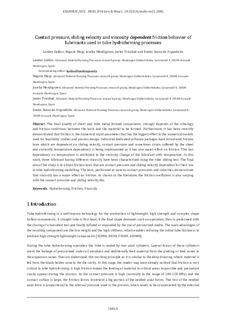| dc.rights.license | Attribution 4.0 International | * |
| dc.contributor.author | GALDOS, Lander | |
| dc.contributor.author | Otegi, Nagore | |
| dc.contributor.author | Mendiguren, Joseba | |
| dc.contributor.author | Trinidad Naranjo, Javier | |
| dc.contributor.author | Sáenz de Argandoña, Eneko | |
| dc.date.accessioned | 2022-05-09T13:52:14Z | |
| dc.date.available | 2022-05-09T13:52:14Z | |
| dc.date.issued | 2021 | |
| dc.identifier.isbn | 978-287019302-0 | en |
| dc.identifier.other | https://katalogoa.mondragon.edu/janium-bin/janium_login_opac.pl?find&ficha_no=166682 | en |
| dc.identifier.uri | https://hdl.handle.net/20.500.11984/5567 | |
| dc.description.abstract | The final quality of sheet and tube metal formed components strongly depends of the tribology and friction conditions between the tools and the material to be formed. Furthermore, it has been recently demonstrated that friction is the numerical input parameter that has the biggest effect in the numerical models used for feasibility studies and process design. Industrial dedicated software packages have introduced friction laws which are dependent on sliding velocity, contact pressure and sometimes strain suffered by the sheet and currently, temperature dependency is being implemented as it has also major effect on friction. This last dependency on temperature is attributed to the viscosity change of the lubricant with temperature. In this work, three lubricant having different viscosity have been characterized using the tube sliding test. The final aim of the study is to obtain friction laws that are contact pressure and sliding velocity dependent for their use in tube hydroforming modelling. The tests, performed at various contact pressures and velocities, demonstrate that viscosity has a major effect on friction. As shown in the literature, the friction coefficient is also varying with the contact pressure and sliding velocity. | en |
| dc.language.iso | eng | en |
| dc.rights | © 2021 The authors | en |
| dc.rights.uri | http://creativecommons.org/licenses/by/4.0/ | * |
| dc.subject | Hydroforming | en |
| dc.subject | Friction | en |
| dc.subject | Viscosity | en |
| dc.title | Contact pressure, sliding velocity and viscosity dependent friction behavior of lubricants used in tube hydroforming processes | en |
| dc.type | http://purl.org/coar/resource_type/c_c94f | |
| dcterms.accessRights | http://purl.org/coar/access_right/c_abf2 | en |
| dcterms.source | ESAFORM Proceedings | en |
| local.contributor.group | Procesos avanzados de conformación de materiales | es |
| local.description.peerreviewed | true | en |
| local.identifier.doi | https://doi.org/10.25518/esaform21.2081 | |
| local.source.details | N. artículo, 2081, 2021 | en |
| oaire.format.mimetype | application/pdf | |
| oaire.file | $DSPACE\assetstore | |
| oaire.resourceType | http://purl.org/coar/resource_type/c_c94f | en |
| oaire.version | http://purl.org/coar/version/c_970fb48d4fbd8a85 | en |








